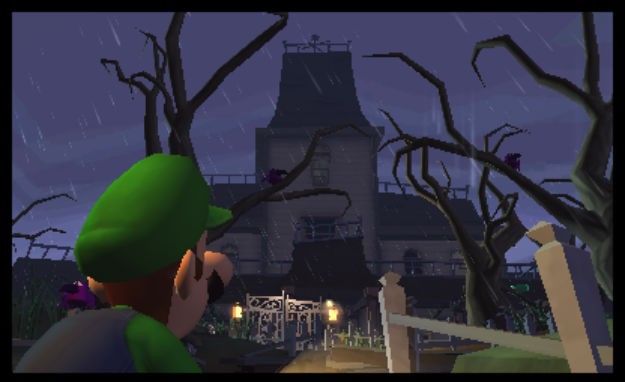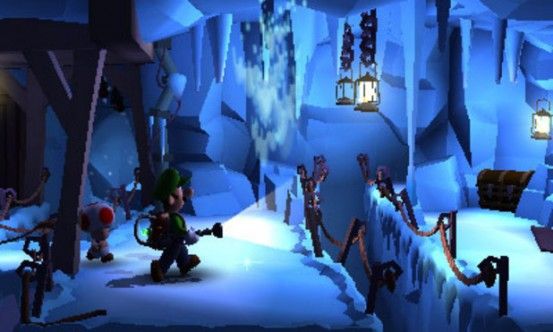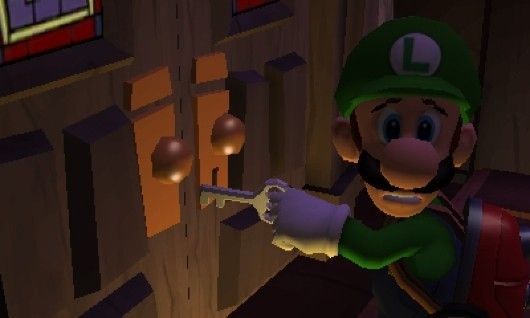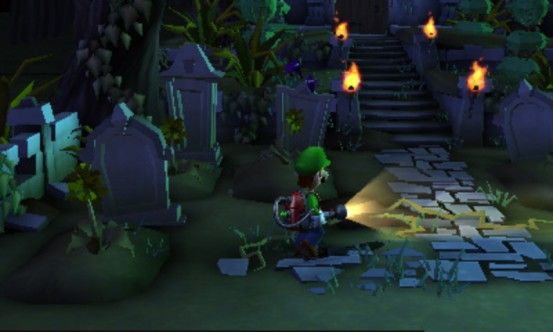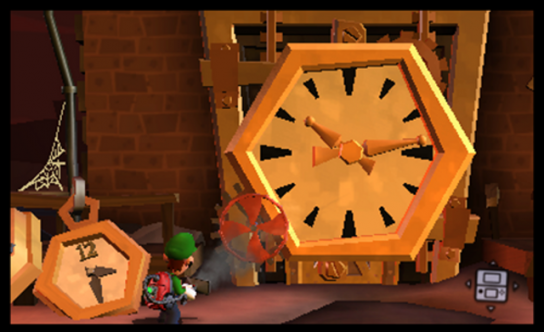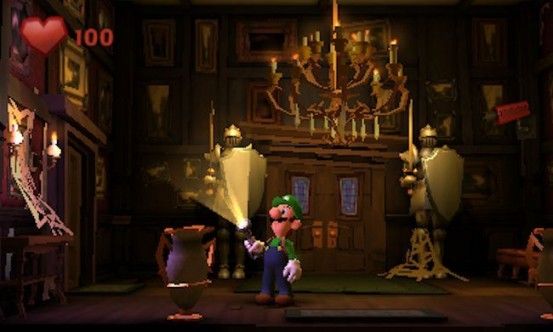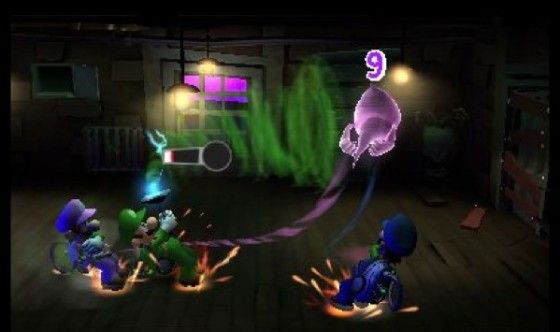Luigi’s Mansion: Dark Moon is the sequel to the well receieved Luigi’s Mansion which hit the Nintendo GameCube over a decade ago. Luigi’s second outing brings him to the Nintendo 3DS and this time he’s even touting multiplayer. The game maintains much of the mysterious, spooky and adventurous charm that made the original so memorable, but is that enough? Does the cowardly Luigi star in yet another hit or is he overshadowed by big brother Mario’s recent adventures?
Luigi’s Mansion: Dark Moon looks pretty solid running on the 3DS. The visuals are bright, colorful and cartoon-like. The use of stereoscopic 3D in the game seems sparring and I absolutely don’t think you would miss out on anything if you played the entire game in 2D. The ghosts all have a bright, spectral look to them and they’re each distinctly colored. The environments showcase an adequate level of detail. I was pleased to see that the entire game wasn’t confined to a single mansion, but that the adventure spans multiple locations.
One of the locations borrows that traditional haunted house motif from the last game, while another location has a Little Shop of Horror-ish motif with viscous plants and spooky greenhouses and yet another stage is set in a haunted museum. The graphics seem choppy in some areas, but the game looks pretty good. I personally wish there was a more prominent use of the console’s 3D function, but it’s forgivable.
The game’s story and music components are both appropriate. Neither is exceptional or terrible but they definitely get the job done. The story focuses on the almighty Dark Moon, which keeps all the ghosts in Evershade Valley docile and kind. One day the Dark Moon is knocked from the sky onto the ground where it shatters into a number of pieces. This sends all of the ghosts into a frenzy and causes them to impede, attack and downright horrify poor Luigi as he journeys to collect all the pieces of the Dark Moon.
I won’t spoil anything but the ending is rather heartwarming and the overall presentation is lighthearted – which is standard fare for Mario games.
The music is quiet and mostly ambient, with spooky strings accompanying the game’s scary atmosphere. I did get a bit tired of the main song that plays while you’re adventuring and what not, but it’s kind of funny to hear Luigi singing along with it. The characters have voices but no one really talks. Professor Gadd spouts out a hilarious series of clicks, hums and other random noises while his dialogue is displayed onscreen. Luigi’s responses are kept brief and he has very little dialogue. He mostly yells “I did it!” at the end of each stage. His lack of enthusiasm is really funny compared to the happy-go-lucky Mario.
In summary, Luigi’s Mansion: Dark Moon sports about the same production values as most new Mario games - which isn't bad, if you didn't know.
The game-play is Dark Moon is unlike any Mario game I’ve played, though. Basically, the game consists of journeying through the various locations while solving puzzles and capturing any ghosts you come across. The game has an overall spooky feeling to it, but it isn’t exactly a horror game like those in the Silent Hill series. It has a more childish, bump-in-the-night feeling to it as opposed to an “Oo my God! That nightmarish monster is running towards me with a giant axe” feeling.
The result is a game that’s exciting without actually ever scaring you gutless – so I think both younger and older players can enjoy it in this regard. Luigi himself is cowardly and fearful compared to Mario. The distress and misery he demonstrates while proceeding through the game was very funny. Throughout the game some locked doors will impede your progress and you’ll have to locate the keys to move on.
Luigi's single tool is his trusty Poltergust 5000. The puzzles in the game all make use of the Poltergust’s functions: the flashlight, the dark light and its ability to pull in or blow out air. Many mechanisms in the game are activated by the flashlight, but it is most important for catching ghosts. The dark light is an interesting device that reveals hidden objects. What’s crazy is that you are never given any warning that something in your vicinity is hidden, so the player will need to pay close attention to the environments to determine whether or not something is missing.
If you ever find yourself stuck, use the dark light on every scare inch of the room. Finally, the Poltergust can pull or suck in air and blow air out as well. This function can be used to snatch down curtains, spin fan propellers and much more. There are several puzzles throughout the game, yet they all somehow make use of these few functions. It’s interesting to see the different ways in which these simple features are used to progress through the game; for example, blowing a vent closed to stop the flowing of smoke into a room and then emptying the room of smoke by sucking it all up.
You’ll also need all of these functions to battle the game’s big variety of ghosts. The first ghosts you come across can all be easily sucked into the Poltergust. First you hit them with the flashlight which stuns them for a set amount of time and then you drain them down into the device. However, things quickly become trickier than this. Many ghosts are strong enough to yank Luigi around a room, meaning you have to hold the circle pad steadily to keep from being thrown to the ground.
Later ghosts come equipped with masks to guard them from the flashlight, weapons to further hurt Luigi with, and others possess objects and safely toss projectiles at Luigi while he’s occupied by any number of other ghosts. Some need to be revealed with the dark light and others spook Luigi, causing him to stop whatever he’s doing. These various kinds of ghosts can cause all sorts of problems for Luigi when they gang up, and the easy task of capturing ghosts quickly becomes a challenging and exciting one.
Aside from ghost catching and puzzle solving, many things in Dark Moon require player investigation and there are many things hidden in the game as well. Each stage holds a dozen or so collectible hidden jewels. These allow for some completionist obsessing, although I didn't pay much mind to them and am not sure what the reward for finding them all is. As you complete the game you’ll collect gold coins and these are used to upgrade the Poltergust. The upgrades do make the Poltergust more effective (for example, a stronger suction to use against the ghosts) but none of them seemed particularly cool or game changing.
Also hidden throughout the various stages are secret treasure rooms. These are tucked away fairly well as I only was able to find two or three throughout the game, although I didn't really search for them. You can also find gold ghosts hiding amongst the stages and capturing these reaps a considerable gold coin bonus. Rounding out the hidden content are the Boos, bigger ghosts captured using the dark light. A boo is hidden in each stage, although finding them will require some investigation. Also, after finishing each stage, an additional boss ghost is unlocked there. This compels you to go back through the stage to defeat this new ghost.
When you lose all of Luigi’s hearts, you are forced to start a stage from the beginning. You are only allowed a continue option if you discovered a golden bone before you were knocked out. The golden bones are hidden randomly throughout the levels, though you have a greater chance of discovering one if you have lots of gold coins. I don’t remember being given an explanation about how the gold bones work, but there you have it.
At the end of each stage you are given a score based on your performance. This considers a number of variables, such as the amount of damage you took, the number of gold coins you found and the amount of time it took you to clear the stage. I spent much longer on some stages than others because I got stuck a couple of times.
All of the ghosts, Boos and gems you discover in the game can be viewed in the vault. The vault is basically a model viewer and it keeps track of everything you’ve found. Professor Gadd urges you to visit the vault many times, but I never really saw an incentive to. The game’s main campaign is meaty, and it took me more than 16 hours to clear it the first time, although as I said I did get stuck here and there and I didn’t exactly race through the title.
In addition to the swell main campaign, Luigi’s Mansion: Dark Moon also has an online suite. You can join and create games with as many as four players and enjoy one of three different game modes in the ScareScraper. Although the modes are different, the general goal of the online modes is to progress to the next floor. A game can be created with as few as five floors or as many as 25, and you can also choose between difficulty settings for more or less challenge. The game doesn't appear to support voice chat, so your communication with the other Luigi’s is limited to four predetermined phrases such as “Help!” and “Thank You!”.
What’s cool about the online suite is that it doesn't feel tacked on or rushed – it feels natural and like a true expansion of the game. The stages created for these modes are linear but big and spacious compared to those in the campaign. Teaming up with other players to tag team some of the big ghosts is fun and exciting. When everybody behaves like a team player, the online mode offers an experience that is both unique from and similar to the main game, while being a highlight of its own.
Coins and ghosts you capture while playing online can be brought back to your single player game (assuming you finished the match and didn't quit) and there are many spots in the vault for ghosts that can only be captured in the ScareScraper. Those interested in the online suite will also be delighted to know that the online community is currently sprawling and very populated. You can log on and hop right into a game as opposed to waiting forever for a match. In traditional Nintendo fashion, the online interactions are severely limited, but everyone is pretty much already aware of what needs to be done and you can call for help at any time easily.
The online mode is Luigi’s Mansion: Dark Moon is pretty much the opposite of “tacked on”. It’s a perfectly legit addition to the game that offers a new way to play and brings other players in on the fun.
As for complaints about the game, I did feel sometimes that Dark Moon was something of kiddie game. However, the game lacks a traditional save/checkpoint system. Trudging through a thirty minute stage only to be knocked out and forced to restart near the end is absolutely not fun. Furthermore, there were several times where I wished that some sort of hint or bone was thrown to me about what to do next. That hint never came. I eventually made my way to the end, and many players enjoy that independent feeling of discovering or figuring things out, but I can honestly imagine several younger players getting indefinitely stuck on some sections.
Also, I’ll mention again that the use of 3D is kind of lacking. It puzzles me when what is arguably the 3DS's strongest feature isn't capitalized upon. However, these are minor gripes about an otherwise really fun and unique gaming experience.
Luigi’s Mansion: Dark Moon is a really enjoyable game. Solving puzzles, trapping ghosts and getting the occasional legitimate spook are all pretty fun. There are lots of things to find and discover and the main campaign is long enough to make it feel worth the money. To top this off, the online mode is strong in its own regard, bringing players together for a unique and enjoyable experience that actually expands the game. It’s exciting, it’s unique and it’s easy to recommend to ghost busters of all ages.
Luigi's Mansion: Dark Moon
- Platform(s)
- 3DS
- Developer(s)
- Next Level Games
- Publisher(s)
- Nintendo
- Genre(s)
- Action, Adventure

